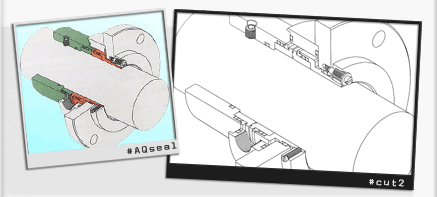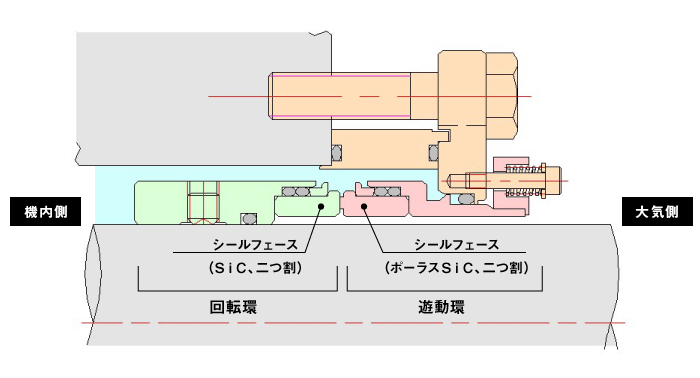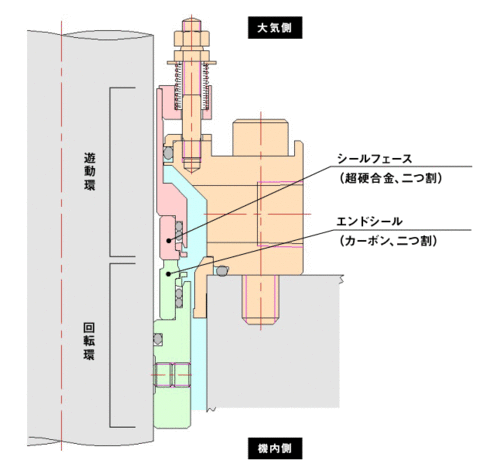
What is Non-Flushing Seal?
Conventional mechanical seals are used by injecting treated water or clean water into the mechanical seal in order to avoid abnormal wear due to sludge (slurry), forced removal of sliding heat generation, and impaired operating performance due to accumulation.
However, when the supply of clean water was stopped due to a major disaster, the sewage that flowed in one after another could not be sent to the treatment plant or relay station because water could not be injected into the mechanical seal. ..
On the other hand, there is an increasing demand for the mechanical seal "Non-Flushing Seal" that does not require water injection in terms of environmental impact such as ISO and cost reduction of equipment and maintenance costs.
At our company, for various problems of mechanical seal generated by sludge (slurry), based on the static structure cultivated over many years, we have adopted original special materials and optimized low heat generation design to meet various specification conditions. We propose the most suitable Non-Flushing Mechanical seal.
However, when the supply of clean water was stopped due to a major disaster, the sewage that flowed in one after another could not be sent to the treatment plant or relay station because water could not be injected into the mechanical seal. ..
On the other hand, there is an increasing demand for the mechanical seal "Non-Flushing Seal" that does not require water injection in terms of environmental impact such as ISO and cost reduction of equipment and maintenance costs.
At our company, for various problems of mechanical seal generated by sludge (slurry), based on the static structure cultivated over many years, we have adopted original special materials and optimized low heat generation design to meet various specification conditions. We propose the most suitable Non-Flushing Mechanical seal.
Advantages of introduction
1. Response to emergencies
Even if an unexpected situation such as a water outage occurs in the water injection facility, the pump can be operated.
2. Prevention of deterioration of water treatment efficiency
Prevents the sludge concentration from decreasing due to water injection and reduces the processing burden in the subsequent process.
3. Reducing the burden of maintenance
The burden of operation and equipment management associated with water injection is reduced.
4. Reduction of running cost
Eliminates the need for water injection and associated operating costs. Injecting 3 liters of water per minute reaches a total of 1,500 m per year.
5. Reduction of equipment cost
Equipment costs including water injection piping and water injection pump can be reduced.
Be applicable
| Type | Horizontal Aqua-less Seal | Vertical Aqua-less Seal |
Model | BO71-SV, BO71-GV | BO71-GY, BO23-GD |
Fluid | Various sludges (surplus, return, digestion) Wastewater, cold water, cooling water | Sewage, rainwater, river water, cold water |
Main adopted equipment | Single suction volume pump Double suction volume pump Screw pump Slurry pump | Double suction volume pump Screw pump Vertical mixed flow pump Vertical volume pump Horizontal axial flow pump |
Slurry concentration | 4.0 Wt% or less | 1.0 Wt% or less |
Shaft diameter | φ30-φ120 | φ50-φ300 |
pressure | 1.0MPa | 1.0MPa |
Peripheral speed | 10m/s | 10m/s |
Features
| Type | Horizontal Aqua-less Seal | Vertical Aqua-less Seal |
Construction | Static Inside type (Consumable parts Split: GV type) | Static Inside type Consumable parts Split (Cartridge: GD type) |
Material | Sliding parts: Silicon Carbide x Silicon Carbide Packing: FKM Metal parts: SUS304, SUS316 | Sliding parts: Carbon "F42" x WC (Silicon Carbide) Packing: FKM Metal parts: SUS304, SUS316 |
Others |
|
|
Reference diagram
Aqua-less Seal usage example
[Horizontal sludge pump at sewage treatment plant] and [Vertical sewage pump at relay pump station]
By eliminating the need to inject fresh water from the outside, it contributes to the reduction of water injection costs and ancillary equipment such as piping.In addition, since the consumable Sliding material and packing have a split structure, maintenance is possible without disassembling the pump when replacing the seal.
Non-Flushing specifications
Since it is not necessary to inject water into the seal part, it is possible to reduce the water injection cost. It also eliminates the need for installation and maintenance of water injection pipes to the pump.




